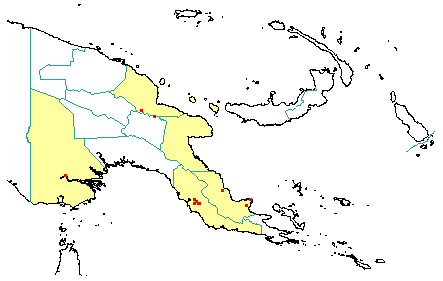
in PNGplants database
PNGTreesKey – Tetrameles nudiflora R.Br. |
Barry Conn (NSW) & Kipiro Damas (LAE).
Guide to trees of Papua New Guinea
Copyright held by the authors, National Herbarium of New South Wales, and Papua New Guinea National Herbarium
Plantae Javanicae Rariores 79 (1838)
Other Literature: J.R. Croft, Handbooks of the Flora of Papua New Guinea 120-122 (1978) Fig. 62.
Family: Tetramelaceae
Dicotyledon
Timber Group: Minor hardwood
Field Characters: Large canopy tree (25-45 m high); Bole cylindrical (usually up to 200 cm diam.) or often markedly fluted; slightly crooked or straight (bole 20-35 m long); buttresses buttresses present (up to 5 m high); spines spines absent; aerial roots aerial roots absent; stilt roots stilt roots absent; Bark greyish green, grey, or slightly brown, slightly rough or almost smooth, scaly or flaky (shedding in irregular flakes) or fissured; Subrhytidome (under-bark) green, red, or mottled; less than 25 mm thick, 15.0-20.0; bark blaze consisting of one layer; strongly aromatic; unpleasant; outer blaze white (cream-coloured) or pale yellow, with stripes (white), fibrous; inner blaze white (cream-coloured) or pale yellow, with stripes (white), fibrous; bark exudate (sap) absent; terminal buds not enclosed by leaves.
Indumentum: Complex hairs absent; stinging hairs absent; mature twig indumentum (hairs) absent.
Leaves: Leaves spaced along branches (deciduous), spiral (leaves occurring singly at a node and arranged spirally up the branchlet), simple (a leaf composed of a single blade); petiole present, not winged, attached to base of leaf blade, not swollen; leaves broadest below middle, 10.0-25.0 cm, 9.0-20.0 cm; symmetric, sub entire or crenate, not dissected or lobed, acuminate, venation distally pinnate or at base palmate, secondary veins open, prominent, intramarginal veins absent; leaves lower surface green or yellow, upper surface dull green, indumentum (hairs) absent (usually on upper surface) or present (lower surface), indumentum (hairs) dense to sparse; absent; domatia absent; stipules absent.
Flowers: Inflorescence terminal (when tree leafless), flowers on an unbranched axis to flowers on a branched axis, cones absent; flowers unisexual, unisexual with male and female flowers on different plants, not stalked to stalked (shortly), flowers with many planes of symmetry, 1.5-5.0 mm long, diameter small (up to10 mm diam.); perianth present, with all sepals and/or petals (hence tepals) similar, inner perianth white to cream-coloured; 4-5, some or partly joined; stamens 4 (absent in female flowers), present, free of each other, joined to the perianth; ovary inferior, carpels joined (when more than one), locules 1; styles free, 4 (-5).
Fruits: Infrutescence arranged on unbranched axis to arranged on branched axis (fruits grouped in whorls around inflorescence axis), fruit 4.0-5.0 mm long, brown, not spiny, non-fleshy, simple, dehiscent, capsule; seeds 100, barely visible (to 1 mm long) (c. 1 mm long), not winged, broad (as wide as long), seed less than 1 mm diam. (c. 1 mm long).
Distribution: Madang, Morobe, Western, Central, Northern.
 | Botanical records in PNGplants database |
Notes: Notes The genus Tetrameles was previously classified in the family Datiscaceae.